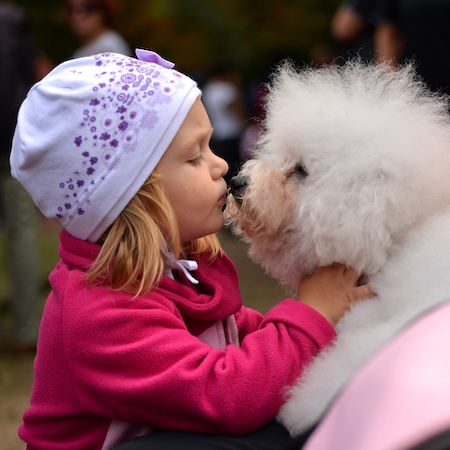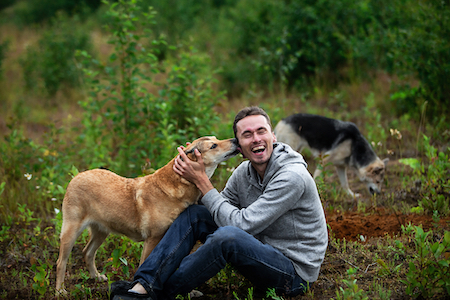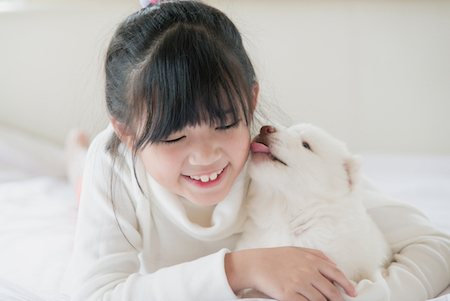A dog’s lick is a sign of love and affection. But should you let your dog kiss you? What does the research say? This article will explore the possible risks and benefits of dog kisses. We’ll also discuss some tips for preventing dog-to-human disease transmission. So, should you let your furry baby kiss your face? Read on to find out!

Why do dogs lick their owners’ faces?
Licking is the primary way mother dogs show affection to their puppies from birth. This behavior stems from inherent canine traits and serves as a means for bonding and communication.
Mother dogs will use a licking technique to clean the puppies after birth and stimulate breathing. The puppies learn that reciprocating this action promotes feelings of affection and protection. This action releases endorphins that provide them with pleasure and help relieve stress. Some dogs resort to obsessive licking behaviors when they’re anxious or stressed.
A mother dog will groom her puppies with her tongue and even teach them how to go to the bathroom. As the puppies transition from drinking the mother’s milk to eating solid foods, they will lick at their mother’s mouth to taste her dinner. In a pack, licking is a sign of submission from one dog to a dominant group member. Therefore, this action is a significant mode of communication in a dog’s life.
What does it mean when your dog licks your face? Generally, it means that your pup loves you and licks as a sign of affection, much like when she was a puppy with her mother. It may also signify submission to you as the “pack leader.” Of course, if you’ve eaten something recently, your dog could also lick your face to get a small taste of your meal.

Are dog kisses safe?
Most pet owners cherish the moments their dogs lick or “kiss” their faces. But let’s be honest — that tongue has been on the floor, slurping water out of the toilet bowl or outside in a dirty puddle, or sniffing dead animals, and often, licking their genitals and sniffing their own butts. The canine mouth, nose, and muzzle become host to various bacteria, which are then transferred to your face when your pup comes in for some smooching. So does that make dog kisses unsafe for people?
The answer is yes and no, depending on the circumstances. The adage that a dog’s mouth is cleaner than a person’s is strictly a myth. In reality, canines and humans have a unique normal flora of bacterial species in their mouths to keep a balance. Due to the bacteria’s uniqueness, people cannot compare them with each other.
For the most part, dog bacteria are relatively harmless if it comes in contact with intact skin. However, it may be the brewing ground for infection and irritation with broken skin. Human skin cannot absorb the bacteria deposited by that doggy smooch; the pathogens only enter through the mucus membranes of the face, including the eyes, nose, and mouth. Try, if possible, not to allow your dog to lick you in these areas.

What exactly is in a dog’s mouth?
Although the bacteria in the canine mouth may not severely impact your health, dog owners should know what’s inside those pooches’ smooches. Dog saliva contains proteins and organisms that people cannot tolerate. Some canine bacteria are zoonotic, meaning the bacteria pass from animals or pets to people.
Here are common bacterias found in the canine mouth:
- Capnocytophaga canimorsus (campylobacter): an organism that causes dangerous sepsis infections and which, in 2017, spread from puppies to people in a seven-state outbreak; veterinary medicine shows it has become multidrug-resistant;
- Salmonella: a bacterial disease that causes intestinal cramping, nausea, vomiting, and diarrhea;
- Staphylococcus Aureu (staph infection): a virus strain carried by canines without harming their health. It can result in emergency medical situations when transmitted to a person.
- E. Coli: a potentially life-threatening bacteria that contains symptoms ranging from nausea to diarrhea to intestinal bleeding;
- Hookworms or ringworms: at the point of entry, these organisms will cause skin inflammation or painful, itchy infections, and possibly, intestinal bleeding;
- Clostridium (difficile or perfringens): a bacterial infection that impacts the intestinal tracts, causing high fevers, vomiting, dehydration, abdominal cramps, severe diarrhea, and lethargy. Scientists note that dogs who come into contact with an infected dog’s feces may spread this bacteria to their owners through saliva.
While all these transmissions could occur when your dog licks your face, the fact is that the odds of zoonotic spread are slim. That doesn’t mean the risk isn’t there, just that many pup parents may choose to let their dog lick them based on the low chances of bacterial spread. However, some people can suffer harm from a dog lick and should be careful around their pups.

Who can be harmed by dog kisses?
Dog lovers should be aware that the risk of an average person contracting illness from dog kisses is low. That said, researchers and scientists argue there are some individuals for whom this risk could prove too significant. Clinical microbiology suggests that dogs should not be allowed to lick people in these categories:
- people with compromised immune systems (diabetics, COVID, transplant patients, cancer patients, HIV/AIDS patients);
- people with scratches or open sores or wounds;
- babies and young children;
- pregnant women;
- the elderly.
The risk of getting illnesses and viruses from zoonotic pathogens is higher for immunocompromised people. Those individuals in these situations should avoid letting dogs lick their faces and wash their hands immediately after handling or petting dogs to prevent becoming sick.

What should you do after your dog licks your face?
What should you do if your dog plants a big, sloppy kiss on your face? It’s easy: practice basic hygiene habits. Wash your face right after your dog has kissed you. Don’t worry — she won’t take offense!
You can prevent further bacterial transmissions by being a responsible pup parent with the following steps:
- Regular veterinary care goes a long way toward preventing infections from being passed from canines to humans.
- Take your dog for an annual check-up and fecal exam to ensure she is free of parasites like worms, ticks, or fleas.
- Always properly dispose of your dog’s stool and thoroughly wash your hands afterward.
- Brush your dog’s teeth and mouth regularly to maintain her oral health and kill the bacteria lurking there.

To smooch or not to smooch: a personal pup parent choice.
If you love getting kisses from your dog, there’s no need to stop doing so as long as you are healthy and your immune system is robust. Most people and pet owners enjoy this cute show of love from their dogs; others may feel the action is gross and unsanitary. While illness from bacteria or germs in the canine mouth is rare, it’s not impossible. To be on the safe side, continue to clean your face and hands after coming into contact with a pup’s mouth. Keep up a good hand sanitary routine by washing them often.
Ultimately, it’s a personal decision whether or not you want to let your dog kiss your face. If the slight risk doesn’t bother you, and you are not vulnerable to diseases, then get ready for some smooches from your beloved dog.
Pucker up with a pet insurance plan for your pup!
Show your dog the ultimate sign of love with a pet insurance plan. You can choose your policy based on your dog’s needs and your finances. Emergencies may happen at any time to our pets. However, with a pet insurance plan, you can rest assured your pets will get the treatment they need without you stressing over the costs.
Let Pet Insurance Review help you find the best dog health insurance today. Start with a free quote to get the best protection for your pup right now.
References:
- Santos, N.R., Beck, A., Fontbonne, A. (2019). A review of maternal behaviour in dogs and potential areas for further research: Maternal behaviour in dogs. Retrieved from https://www.researchgate.net/publication/337800324_A_review_of_maternal_behaviour_in_dogs_and_potential_areas_for_further_research_Maternal_behaviour_in_dogs
- Zaman, D. (2018). 7 Signs That Your Dog See You As Pack Leader. Retrieved from https://www.wagthedoguk.com/2018/05/26/7-signs-dog-sees-pack-leader/
- Oregon Veterinary Medical Association. (2019). Zoonotic Diseases & Dogs. Retrieved from https://oregonvma.org/care-health/zoonotic-diseases/zoonotic-diseases-dogs
- Kee, C. (2017). Puppies MIght Be Causing A Diarrheal Illness Outbreak in Seven States. Retrieved from https://www.buzzfeednews.com/article/carolinekee/campylobacter-outbreak-linked-to-petland-puppies#.wxXLMkMBX
- Centers for Disease Control and Prevention. (2021). Outbreak of Multidrug-resistant Campylobacter Infections Linked to Contact with Pet Store Puppies. Retrieved from https://www.cdc.gov/campylobacter/outbreaks/puppies-12-19/index.html
- Istituto Zooprofilattico Sperimentale delle Venezie. (2016). Clostridium difficile in dogs and humans: the results of an epidemiological study. Retrieved from https://www.izsvenezie.com/clostridium-difficile-dogs-humans/
- Stull, J., Brophy, J., Weese, J.S. (2015). Reducing the risk of pet-associated zoonotic infections. Retrieved from https://www.ncbi.nlm.nih.gov/pmc/articles/PMC4500695/
Disclaimer
The information contained on this blog is intended for informational and educational purposes only and should not be construed as medical advice. It is not a substitute for professional veterinary care. Always consult with your veterinarian before making any changes to your pet's health care or treatment plan.
The authors of this blog are not veterinarians and do not claim to be experts in pet health. The information provided here is based on our own experiences and research, as well as information from reputable sources. However, we cannot guarantee the accuracy or completeness of this information.
We encourage you to do your own research and consult with your veterinarian before making any decisions about your pet's health.
Previous post
Flying with Your Dog: Tips and TricksNext post
Hip Dysplasia in DogsCompare top pet insurance providers & plans.
Enter your dog’s age in years and months to calculate their age equivalent to human years.
Calculate your dog’s ageEnter your cat’s age in years and months to calculate their age equivalent to human years.
Calculate your cat’s age